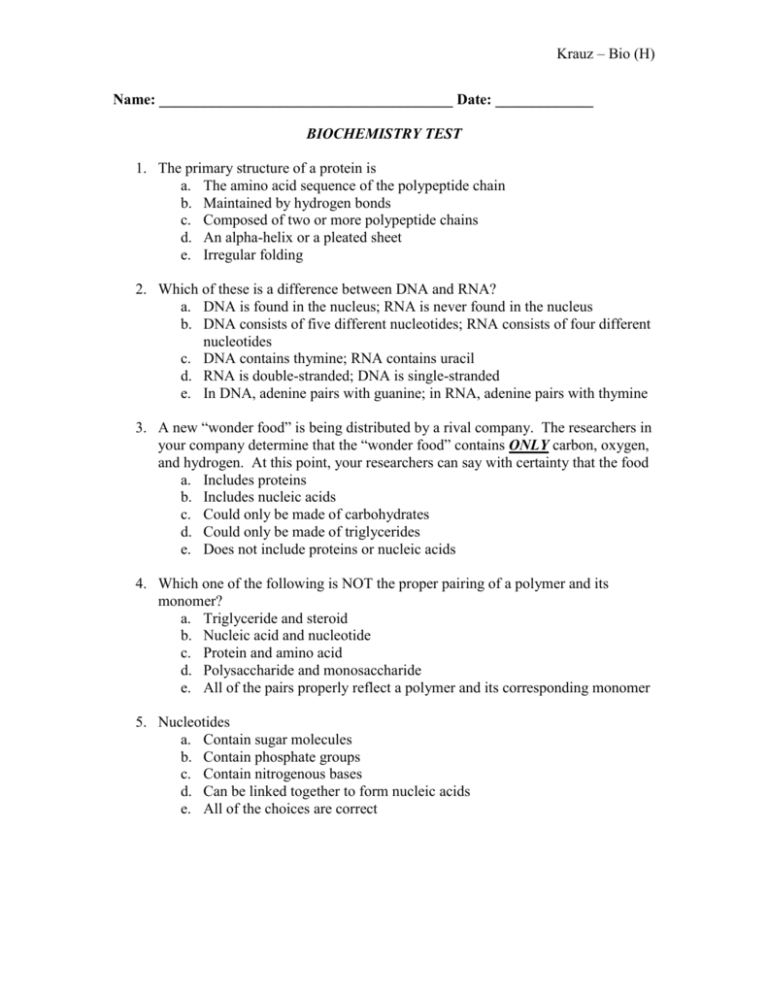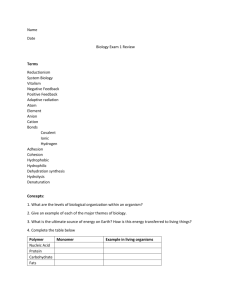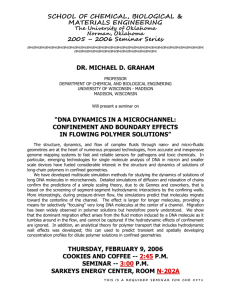regions nucleic
advertisement

Krauz – Bio (H) Name: _______________________________________ Date: _____________ BIOCHEMISTRY TEST 1. The primary structure of a protein is a. The amino acid sequence of the polypeptide chain b. Maintained by hydrogen bonds c. Composed of two or more polypeptide chains d. An alpha-helix or a pleated sheet e. Irregular folding 2. Which of these is a difference between DNA and RNA? a. DNA is found in the nucleus; RNA is never found in the nucleus b. DNA consists of five different nucleotides; RNA consists of four different nucleotides c. DNA contains thymine; RNA contains uracil d. RNA is double-stranded; DNA is single-stranded e. In DNA, adenine pairs with guanine; in RNA, adenine pairs with thymine 3. A new “wonder food” is being distributed by a rival company. The researchers in your company determine that the “wonder food” contains ONLY carbon, oxygen, and hydrogen. At this point, your researchers can say with certainty that the food a. Includes proteins b. Includes nucleic acids c. Could only be made of carbohydrates d. Could only be made of triglycerides e. Does not include proteins or nucleic acids 4. Which one of the following is NOT the proper pairing of a polymer and its monomer? a. Triglyceride and steroid b. Nucleic acid and nucleotide c. Protein and amino acid d. Polysaccharide and monosaccharide e. All of the pairs properly reflect a polymer and its corresponding monomer 5. Nucleotides a. Contain sugar molecules b. Contain phosphate groups c. Contain nitrogenous bases d. Can be linked together to form nucleic acids e. All of the choices are correct Krauz – Bio (H) 6. Because water and oil don’t mix, water is not very effective at washing away oily dirt. The ability of soap to mix with both water and oily dirty allows dirt to be washed away. Which statement provides the most logical chemical explanation for this phenomenon? a. Soap molecules have both positively and negatively chard regions. The negatively charged regions are attracted to water; the positively charged regions are attracted to oil b. Soap molecules carry no charge. As a result, soap can form an effective bridge between charged water molecules and neutral oil molecules c. Soap molecules have charged regions and neutral regions; the charged regions are attracted to water molecules; the neutral regions are attracted to oils d. Soap molecules have both positively and negatively charged regions. The positively charged regions are attracted to water; the negatively charged regions are attracted to oil e. Soap molecules have charged regions and neutral regions. The neutral regions are attracted to water molecules; the charged regions are attracted to oils 7. Which of the following best summarizes the relationship between dehydration reactions and hydrolysis? a. Dehydration reactions assemble polymers, and hydrolysis breaks down polymers b. Hydrolysis only occurs in the urinary system, and dehydration reactions only occur in the digestive tract c. Dehydration reactions can occur only after hydrolysis d. Hydrolysis creates monomers, and dehydration reactions break down polymers e. A and C are correct FIGURE 5.1 8. If 128 molecules of the general type shown in Figure 5.1 were covalently joined together in sequence, the single molecules that would result would be a a. Polysaccharide b. Polypeptide c. Polyunsaturated lipid d. Monosaccharide e. Disaccharide Krauz – Bio (H) 9. Which of the following is TRUE of cellulose a. It is a polymer composed of sucrose monomers b. It is a storage polysaccharide for energy in plant cells c. It is a storage polysaccharide for energy in animal cells d. It is a major structural component of plant cell walls e. It is a major structural component of animal cell plasma membranes FIGURE 5.2 10. What is the molecule illustrated in Figure 5.2? a. A saturated fatty acid b. An unsaturated fatty acid c. A polyunsaturated triglyceride d. A trans polyunsaturated triglyceride e. A steroid similar to cholesterol 11. The tertiary structure of a polypeptide refers to a. Its size b. The presence of pleated sheets c. The number of R groups it contains d. The overall three-dimensional structure e. The amino acids of which it is made FIGURE 5.4 12. What is the structure shown in Figure 5.4? a. Starch molecule b. Protein molecule c. Steroid molecule d. Cellulose molecule e. Phospholipids Krauz – Bio (H) 13. A polypeptide can best be described as a a. Monomer of a protein polymer b. Polymer containing 20 amino acid molecules c. Polymer containing 19 peptide bonds d. Polymer containing 20 peptide bonds e. Polymer of amino acids FIGURE 5.5 14. The chemical reaction illustrated in Figure 5.5 results in the formation of a (an) a. Ionic bond b. Peptide bond c. Glycosidic linkage d. Ester linkage e. Phosphodiester linkage 15. All of the following nitrogenous bases are found in DNA except a. Thymine b. Adenine c. Uracil d. Guanine e. Cytosine 16. Polysaccharides, lipids, and proteins are similar in that they a. Are synthesized from monomers by the process of hydrolysis b. Are synthesized from monomers by dehydration reactions c. Are synthesized as a result of peptide bond formation between monomers d. Are decomposed into their subunits by dehydration reactions e. All contain nitrogen in their monomer building blocks Krauz – Bio (H) 17. At which bond would water need to be added to achieve hydrolysis of the peptide, back to its component amino acid? a. A b. B c. C d. D e. E 18. What maintains the secondary structure of a protein? a. Peptide bonds b. Hydrogen bonds c. Disulfide bonds d. Ionic bonds e. Phosphodiester bonds 19. Consider a polysaccharide of 576 glucose molecules. The total hydrolysis of the polysaccharide would result in the production of a. 575 glucose molecules b. 575 water molecules c. 576 glucose molecules d. A and B only e. B and C only 20. The alpha-helix and the Beta-pleated sheet are both common polypeptide forms found in which level of protein structure? a. Primary b. Secondary c. Tertiary d. Quaternary e. All of the above Krauz – Bio (H) FIGURE 5.7 21. Figure 5.7 best illustrates the a. Secondary structure of a polypeptide b. Tertiary structure of a polypeptide c. Quaternary structure of a protein d. Double helix structure of DNA e. Primary structure of a polysaccharide 22. Which of the following BEST describes the flow of information in eukaryotic cells a. DNA RNA proteins b. RNA proteins DNA c. Proteins DNA RNA d. RNA DNA proteins e. DNA proteins RNA 23. Which of the following are nitrogenous bases of the pyrimidine type? a. Guanine and adenine b. Cytosine and uracil c. Thymine and guanine d. Ribose and deoxyribose e. Adenine and thymine 24. The difference between the sugar in DNA and the sugar in RNA is that the sugar in DNA a. Is a six-carbon sugar and the sugar in RNA is a five-carbon sugar b. Can form a double-stranded molecule c. Has a six-membered ring of carbon and nitrogen atoms d. Can attach to a phosphate e. Contains one less oxygen atom Krauz – Bio (H) 25. Which of the following molecules are structural isomers? a. 1 and 4 b. 5 and 14 c. 6 and 12 d. 12 and 13 e. 14 and 15 Krauz – Bio (H) 26. Which of the following molecules is (are) a carbohydrate? a. 13 b. 6 c. 11 d. 5 and 14 e. All of the above 27. Which of the following molecules is a purine type of nitrogenous base? a. 2 b. 3 c. 5 d. 12 e. 13 28. Which of the following molecules consists of a hydrophilic “head” region and a hydrophobic “tail” region? a. 2 b. 5 c. 7 d. 9 e. 11 29. Which is an amino functional group? a. A b. B c. C d. D e. E 30. Which is an acidic functional group that can dissociate and release H+ into solution? a. A b. B c. C d. D e. E Krauz – Bio (H) SHORT ANSWER 31. In the space on your answer paper sketch the hydrolysis of a triglyceride. (Show all steps) 32. In the space provided, answer the following a. Explain the function of an enzyme. b. Describe and explain the “Lock and Key” Model (use diagrams) c. Describe and explain the “Induced Fit” Model (use diagrams) Krauz – Bio (H) ANSWER SHEET Multiple Choice 1. ________ 16. ________ 2. ________ 17. ________ 3. ________ 18. ________ 4. ________ 19. ________ 5. ________ 20. ________ 6. ________ 21. ________ 7. ________ 22. ________ 8. ________ 23. ________ 9. ________ 24. ________ 10. ________ 25. ________ 11. ________ 26. ________ 12. ________ 27. ________ 13. ________ 28. ________ 14. ________ 29. ________ 15. ________ 30. ________ Krauz – Bio (H) SHORT ANSWER a) __________________________________________________________________ __________________________________________________________________ __________________________________________________________________ __________________________________________________________________ __________________________________________________________________ __________________________________________________________________ __________________________________________________________________ __________________________________________________________________ __________________________________________________________________ __________________________________________________________________ __________________________________________________________________ __________________________________________________________________ __________________________________________________________________ __________________________________________________________________ __________________________________________________________________ __________________________________________________________________ __________________________________________________________________ __________________________________________________________________ b) __________________________________________________________________ __________________________________________________________________ __________________________________________________________________ __________________________________________________________________ __________________________________________________________________ __________________________________________________________________ __________________________________________________________________ __________________________________________________________________ __________________________________________________________________ __________________________________________________________________ __________________________________________________________________ __________________________________________________________________ __________________________________________________________________ __________________________________________________________________ __________________________________________________________________ __________________________________________________________________ __________________________________________________________________ __________________________________________________________________







